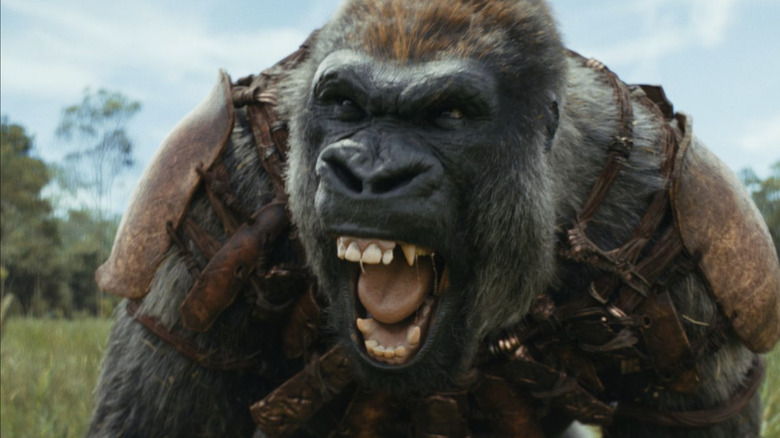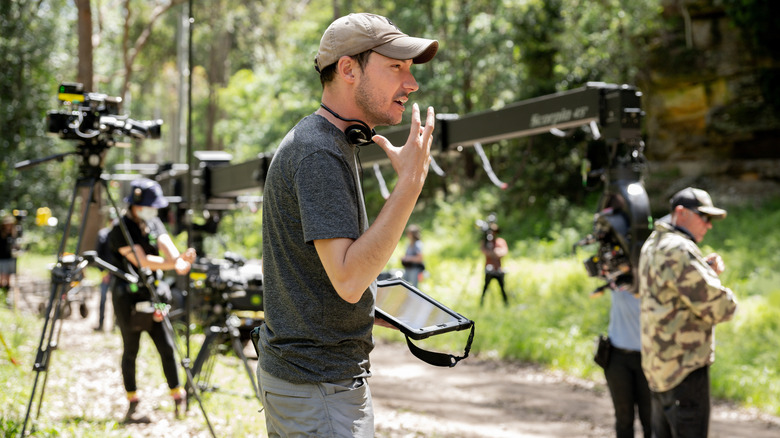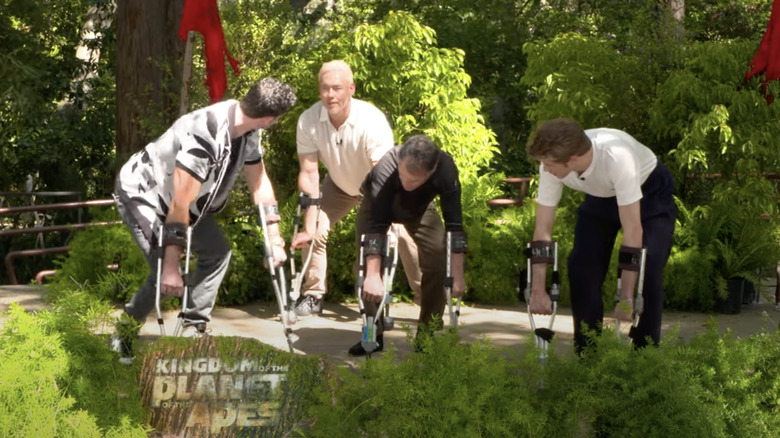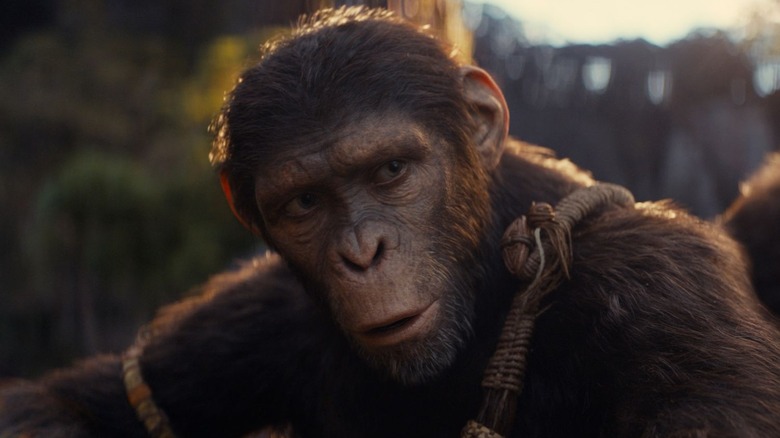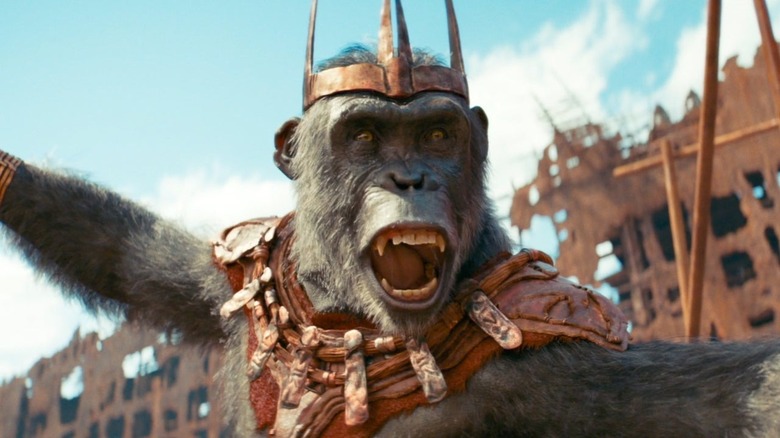Kingdom Of The Planet Of The Apes Looks Utterly Wild Without Special Effects
When 20th Century Fox began production on the first "Planet of the Apes" film, they enlisted special effects makeup artist John Chambers to help transform actors like Roddy McDowall, Kim Hunter, Maurice Evans, and James Whitmore into anthropomorphic apes. Chambers was already famous for having perfected Spock's Vulcan ears on "Star Trek," but a society of intelligent apes who were capable of communicating was like something straight out of "The Twilight Zone." Rather than create ape masks, Chambers instead crafted individual prosthetic pieces to be applied in sections, allowing the actors to emote with their own facial muscles — a technique that revolutionized the art of special effects makeup.
Now, over 50 years later, the intelligent apes have traded practical makeup prosthetics in favor of breathtaking and realistic digital artistry. When it comes to 2011's "Rise of the Planet of the Apes," /Film's Larry Fried declared, "There is simply no greater digitally-realized character than Caesar (Andy Serkis), cinema's first-ever photorealistic leading ape and one of modern filmmaking's most complex and challenging characters." 13 years later, "Kingdom of the Planet of the Apes" is taking things a step further, incorporating multiple apes of different species with their own emotional arcs and utilizing Wētā FX's state-of-the-art technological advancements.
"Kingdom of the Planet of the Apes" is a lush, beautiful action/adventure film with remarkably realistic animals, but it's seeing the footage of the actors performing before any digital manipulation that truly showcases what an impressive accomplishment these films are. Actors completely transform their bodies, faces, and voices to assist with the believability of the apes instead of relying on the CGI that will be added in post-production. The results are utterly wild, and double as the greatest argument against AI "art."
Kingdom of the Planet of the Apes' environment is mostly practical
"Kingdom of the Planet of the Apes" takes place on Earth a few hundred years after the events of "War for the Planet of the Apes," which is set in approximately 2028. Nature has, for the most part, taken back the planet, with most building structures covered with greenery or destroyed by time. Instead of relying solely on digital backgrounds, director Wes Ball elected to shoot on location to help seamlessly blend the digital effects of the apes with a tangible world. As he told Collider during a Directors on Directing panel at WonderCon, "We probably had one blue screen set on the movie. For the most part, we're out in real locations shooting with real actors." This meant taking the risk of shooting in unpredictable environments in order to form a more realistic setting.
Ball also told Collider that to pull it off, there were many cameras utilized to capture every possible angle of the actors to assist with the later digital effects. "I've got a camera on one face, and I've got about half-a-dozen to two dozen infrared cameras that are hiding in the set, behind little things of leaves, or whatever, just camouflaged on the set, that are actually the technical craft process of capturing all of this information so that we can get it right," he explained. This technique of blending practical sets with CGI enhancements also helps trick the brain — preventing us from involuntarily "looking for the seams" — and fall into a world of believability instead. "There's about 30 to 40 minutes of full CG, which I don't think people will be able to tell, there's some scenes that you would never guess, just because that's how it had to get done," said Ball. "But it all started from a real camera, and a real world with real, physical actions."
Actors learned to mimic apes using specialized crutches
Apes all move differently depending on their species, which meant that the actors had to learn how to hold their bodies in ways that more closely resemble our evolutionary siblings. Alain Gauthier served as the movement coordinator and choreographer on "Kingdom of the Planet of the Apes," and conducted an "Ape School" for all of the actors to better understand how to walk, run, tip-toe, balance, and believably act like an ape. During a press junket for the film, journalists, including Comicbook.com special assignment producer Brandon Davis, got a crash course in Ape School with instruction from Gauthier and assistance from film stars Owen Teague (Noa) and Kevin Durand (Proximus Caesar). According to Gauthier, Teague and Durand were also the actors who took to acting like apes most quickly, with Durand hailed for his familiarity playing such physical roles.
"[Durand and I] did have a one-on-one for a while together, so that obviously accelerated things, but he took to it really [quickly]," said Gauthier, "And Owen [laughs] he's just been hanging out with Apes too much!" It's all a matter of understanding the differences between ape body structures and human body structures. Keeping the knees bent, the back straight, the hips rounded, the head forward, and remembering to move the entire body when moving as ape hips are higher and have limited torsion are the key basics to moving like an ape. "We all have completely unique ways of moving as our apes," said Teague.
Durand noted that director Wes Ball said that even if only looking at the skeletal dots of the CGI tracking markers, he could tell which actor was who solely based on movement — because the personalities of the physicality were all unique to the performer.
Kingdom of the Planet of the Apes used ethical machine learning
As the threat of AI continues to worry many creatives, Wētā FX is paving the way for ethical uses of machine learning via something they call "a solver." It is essentially an algorithm processing input data (like tracking dots on an actor's face or a motion capture suit) and trying to match where the movement should go from one frame to the next. It's especially useful when making the apes' faces look realistic. According to an interview with Polygon, it's also an extension of the technology developed for Josh Brolin's face as Thanos in the "Avengers" movies. In the words of "Kingdom of the Planet of the Apes" visual effects supervisor Erik Winquist, "Solvers might manipulate digital ape models to roughly match the actors' mouth shapes and lip-synching, giving the faces the vague creases and wrinkles you might expect to form with each word."
However, it's an imperfect science and still requires the artistry of humans to guarantee the apes look as best as possible — because no solver will ever be able to match the necessary human element of filmmaking. "It meant that our facial animators can use it as a stepping-stone, essentially, or a trampoline," Winquist told Polygon through a laugh. "So [they can] spend their time really polishing and looking for any places where the solver was doing something on an ape face that didn't really convey what the actor was doing." This means animators don't have to get hung up with the tedious technical details and can instead focus on the emotional subtleties of a more "human" expression. This, in turn, means that the emotion on display from the apes is not artificial; it's the work of incredibly talented actors shining through.
Kingdom of the Planet of the Apes will be released pre-CGI
For those interested in seeing more of how "Kingdom of the Planet of the Apes" came to be before the digital effects were added, 20th Century Studios has already announced that the physical media release of the film will contain a special bonus feature of the entire film without CGI. As director Wes Ball told Games Radar, "I'm doing a little thing for the DVD where you can watch the movie — the entire movie — with the raw dailies. I'm working on that, where you'll be able to watch and see both the final [cut] and the raw dailies. You can see how close they get, what they do, and how they stitch everything together. It's amazing, and you can just sit there and enjoy it." This is especially exciting for those who have been decrying the lack of physical media releases, especially those without the added gift of behind-the-scenes special features.
"I'll do some commentary over it with Erik [Winquist], our VFX [supervisor]. I think it's gonna be great. For geeks like us, it's gonna be a first. They've never seen this kind of thing," Ball explained. "Some of the hardest stuff in VFX is how you get CG characters to interact with others. So we have a human girl hugging a CG ape and it's like, 'How do you do that?'" The film is currently crushing it at the box office, so hopefully this will motivate 20th Century Studios to continue the saga of Noa, and audiences will be able to enjoy the continued technological advancements along the way.
"Kingdom of the Planet of the Apes" is now playing in theaters everywhere.
